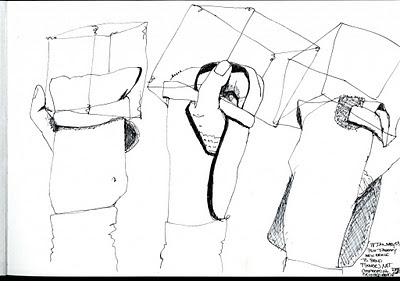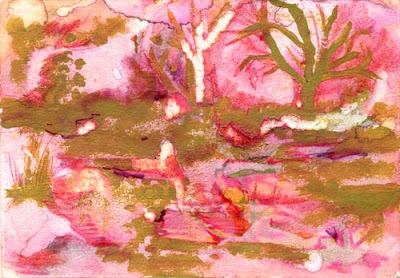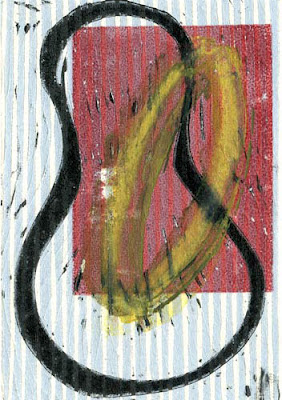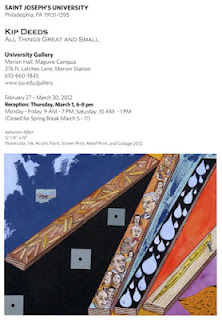I awoke this morning at 7:00 a.m. with acute anxiety (not exactly panic but likely related). My exhibit at Saint Joseph’s University is set to begin in 20 days. The opening is the first Thursday in March. Although tired from restless sleep, I was also jolted by racing thoughts. Building on earlier plans, I began to recall unrecorded details (Why didn’t I write this down sooner?). Now at 7:00 p.m. the picture frames have been ordered, artwork has been chosen, and a delivery plan has been considered. It’s a start, and now the postcard has arrived. Below is an image of my morning notes (a grab at order) as well as exhibit details from the postcard.
Category: Visual Art
Stories, thoughts, and observations about art.
Here & Now: A View From Home
(To learn more about the “Viewfinder Project” see the original post.)
To the right of the computer is an Alvin Cutting Mat (for me this doubles as a mouse pad). Here I noticed the coordinates and measurements and realize my place. I am home.
 |
| Detail: Alvin Cutting Mat |
Two “Viewfinders” that for me point to home are a house image by Pamela Delaura and a painting describing a map by Kariann Fuqua. Especially in the latter case, these images may not be directly connect to a sense of home. However, for me they have stirred a narrative. Images become transformed by what the viewer (in this case myself) brings to the picture. Without the viewer’s interpretation an image lacks meaning. In a similar way, home is a place but it is also a collection of ideas and is built on personal connections.
 |
| Pamela Delaura, Sacked, Collograph & screen-print, 6in. x 4 1/4in., 2006 |
The interior of Pamela Delaura’s print (seen above) seems to refer to a microscopic or biological perspective. In this regard, I see the body as our most earthly home.
 |
| Kariann Fuqua, Viewfinder, painting, 6in. x 4 1/4in., 2006 |
Kariann’s “Viewfinder” (seen above) refers to a map where the curving dotted lines seem to indicate travel or hopping from island to island. I wonder if one can land and feel at home or is this a temporary sensation? Gazing back at the coordinates on my cutting mat, I consider how I decide an exact position. I suspect that thinking we are in the right spot (even if this is our illusion) is more comforting then aimlessness.
A View of Thanksgiving and Beyond
(To learn more about the “Viewfinder Project” see the original post.)
The Winter Solstice will take place (Thursday December 22, 2011) in a little over a month. This has allowed me to consider the qualities of darkness and its psychological range. Darkness will often illicit fear because it obscures sight and represents the unknown. However, darkness also provides the critical function of allowing the eyes to rest. Any relationship with light is bound to darkness (In a broader philosophical way this is expressed in yin and yang). This can become apparent when people pray. Often one’s eyes are closed, in this case putting oneself in darkness, in order to find an inner light.
Julie Mecoli’s “Viewfinder” (seen below) presents darkness in a multifaceted way. It contains cultural references and a range of material applications. She explained to me that this piece reveals a view from her bathroom window of a cathedral. Cathedrals were built to bring in light through stain glass windows and to present devinity through architecture. Ironically, light often casts the exterior of these buildings as a less colorful compared to the surroundings.
 |
| Julie Mecoli, Viewfinder, 4 1/4 inches x 6 inches, (Media: ink, photocopy, tape), 2006 |
Another element in Mecoli’s “Viewfinder” is the portrait. In this case it is self-portraiture developed from observational drawings made using her bathroom mirror. Julie begins by making daily drawings on post-it notes. Then she photocopies them so that one portrait overlaps the next. This means that she feeds the same piece of paper through the copy machine multiple times. Thus, eventually the features of the figure begin to vanish into darkness. Julie told me that the copier can only take this procedure 10 times before it jams.
The layering process that occurs demonstrates how self observation can be intense and at times be destructive while also being a force for positive creative self realization. The portrait is but a representation of one side of ourselves and these portraits serve as reminder that we have a being and a likeness even in darkness.
 |
| Julie Mecoli, Dark Matter Gateway, 34cm x 16cm x 4cm, cast bitumen, 2009 |
Many of Mecoli’s other works feature a contrast between dark and light including a series of sculptures cast in bitumen (an example is seen above). These sculptures slowly change form over time and serve as a reminder that no matter how solid a form or idea it is subject to change depending on the right conditions. Julie has also made a series of drawings and blog posts related to the rehabilitation of her hand (one is featured below). Several of her fingers were crushed in an accident. I am happy to report that Julie is on the mend but do check out her drawings and writing.
 |
| Julie Mecoli, 18 January 2010 Post therapy New device to Bend fingers not cooperating crushed hand + wire cube |
A Working View
(To learn more about the “Viewfinder Project” see the original post.)
Sometimes it is difficult to have a clear view or perspective. One’s mind may be so clouded with thoughts and worries that it is hard to stop and see what is immediate in front of oneself. Relief from this overly stimulated mind may include meditation techniques which center a person in the present. Art making can also shift a persons attention toward specific tasks and away from an overwhelming sense. Creative endeavors can lead to a sense of satisfaction brought about through focus, change, and invention. The key is to be engaged and to work. When doubt is set aside the results can be surprising.
For me, the following “Viewfinders” reflect these artists’ desire to work through problems in order to generate a less predetermined view. I say this because the layering of ink and paint in these examples point toward exploration rather than a succinct resolution. In the first two cases the work literally shows through to the other side of the paper
 |
| Eric Huebsch, Viewfinder, mixed media, 6in x 4 1/4in, 2006 |
Eric Huebsch shows a deftness when drawing a figure wearing rollerblades but the neck and head appear out of control (above). Not only is the neck elongated but I observe at least seven layers of media are used to create this part (e.g. ink, paint, collage,…). At the bottom is the statement “I knew you were no good”. Disturbing as this depiction may seems to be, I know some there is some “good”. No matter how painful a subject may appear the act of making art ultimately is a construction and an imagined representation that can become a focal point for dialogue.
 |
| Rebecca Vicars, Viewfinder, 4 1/4in x 6in, 2006 |
In the image above, Rebecca Vicars creates a view of a lush world full of growth. The description of space is loose and the painterly approach gives it the sense of a swampy wetland. A sense of control is tenuous; watercolor is applied here to provide unpredictable results. There has to be trust by the artist that through a committed effort the picture will come into focus.
 |
| Jennifer Peters, Viewfinder, monoprint, 2006 |
Jennifer Peters Viewfinder combines relief printing with what appears to be a monotype technique. The relief print requires carving to make a matrix that produces the print. What is carved here is premeditated, in the sense that the shapes are clearly defined, but how the shapes come together is less certain to me. The yellow marking, would make the final image a monoprint, was layered last as if to add an exclamation point. It seems to beg the question of when and what is too much? However, doing enough work to get to a point where this question becomes relavent is paramount.
About Order
Tonight I was putting away paperback books I am not likely to read soon. This is being done in an attempt to gain control of my living space. In the process of packing the books, I have found How to Organize Your Work and Your Life. Although I had this book for years, I never studied it thoroughly. The book appears worn and was eventually taped together. This makes me wonder about the people who used the book before me. Could it be that those that read the book were filled with good intentions about organizing there lives and could not meet the suggested advice or is it worn because it was highly affective? In my case, this book has served as a symbol of the organizing I should do. It is also ironic because the function of putting the book away has made me more organized. However, ultimately I am bothered because I can not bring myself to make it disappear.


